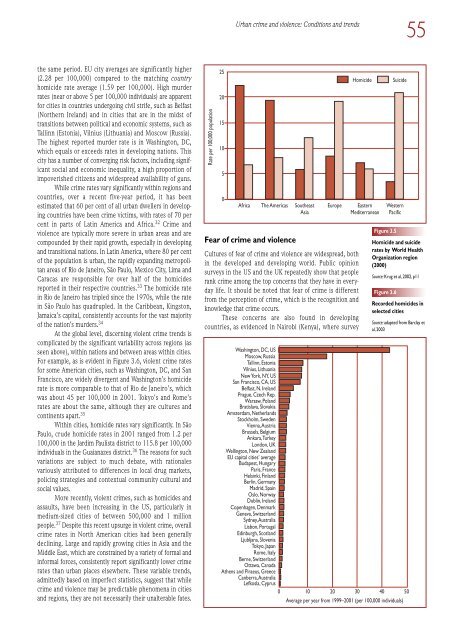Download the file - United Nations Rule of Law
Download the file - United Nations Rule of Law
Download the file - United Nations Rule of Law
- No tags were found...
Create successful ePaper yourself
Turn your PDF publications into a flip-book with our unique Google optimized e-Paper software.
Urban crime and violence: Conditions and trends55<strong>the</strong> same period. EU city averages are significantly higher(2.28 per 100,000) compared to <strong>the</strong> matching countryhomicide rate average (1.59 per 100,000). High murderrates (near or above 5 per 100,000 individuals) are apparentfor cities in countries undergoing civil strife, such as Belfast(Nor<strong>the</strong>rn Ireland) and in cities that are in <strong>the</strong> midst <strong>of</strong>transitions between political and economic systems, such asTallinn (Estonia), Vilnius (Lithuania) and Moscow (Russia).The highest reported murder rate is in Washington, DC,which equals or exceeds rates in developing nations. Thiscity has a number <strong>of</strong> converging risk factors, including significantsocial and economic inequality, a high proportion <strong>of</strong>impoverished citizens and widespread availability <strong>of</strong> guns.While crime rates vary significantly within regions andcountries, over a recent five-year period, it has beenestimated that 60 per cent <strong>of</strong> all urban dwellers in developingcountries have been crime victims, with rates <strong>of</strong> 70 percent in parts <strong>of</strong> Latin America and Africa. 32 Crime andviolence are typically more severe in urban areas and arecompounded by <strong>the</strong>ir rapid growth, especially in developingand transitional nations. In Latin America, where 80 per cent<strong>of</strong> <strong>the</strong> population is urban, <strong>the</strong> rapidly expanding metropolitanareas <strong>of</strong> Rio de Janeiro, São Paulo, Mexico City, Lima andCaracas are responsible for over half <strong>of</strong> <strong>the</strong> homicidesreported in <strong>the</strong>ir respective countries. 33 The homicide ratein Rio de Janeiro has tripled since <strong>the</strong> 1970s, while <strong>the</strong> ratein São Paulo has quadrupled. In <strong>the</strong> Caribbean, Kingston,Jamaica’s capital, consistently accounts for <strong>the</strong> vast majority<strong>of</strong> <strong>the</strong> nation’s murders. 34At <strong>the</strong> global level, discerning violent crime trends iscomplicated by <strong>the</strong> significant variability across regions (asseen above), within nations and between areas within cities.For example, as is evident in Figure 3.6, violent crime ratesfor some American cities, such as Washington, DC, and SanFrancisco, are widely divergent and Washington’s homiciderate is more comparable to that <strong>of</strong> Rio de Janeiro’s, whichwas about 45 per 100,000 in 2001. Tokyo’s and Rome’srates are about <strong>the</strong> same, although <strong>the</strong>y are cultures andcontinents apart. 35Within cities, homicide rates vary significantly. In SãoPaulo, crude homicide rates in 2001 ranged from 1.2 per100,000 in <strong>the</strong> Jardim Paulista district to 115.8 per 100,000individuals in <strong>the</strong> Guaianazes district. 36 The reasons for suchvariations are subject to much debate, with rationalesvariously attributed to differences in local drug markets,policing strategies and contextual community cultural andsocial values.More recently, violent crimes, such as homicides andassaults, have been increasing in <strong>the</strong> US, particularly inmedium-sized cities <strong>of</strong> between 500,000 and 1 millionpeople. 37 Despite this recent upsurge in violent crime, overallcrime rates in North American cities had been generallydeclining. Large and rapidly growing cities in Asia and <strong>the</strong>Middle East, which are constrained by a variety <strong>of</strong> formal andinformal forces, consistently report significantly lower crimerates than urban places elsewhere. These variable trends,admittedly based on imperfect statistics, suggest that whilecrime and violence may be predictable phenomena in citiesand regions, <strong>the</strong>y are not necessarily <strong>the</strong>ir unalterable fates.Rate per 100,000 population2520151050AfricaThe AmericasFear <strong>of</strong> crime and violenceSou<strong>the</strong>astAsiaEuropeCultures <strong>of</strong> fear <strong>of</strong> crime and violence are widespread, bothin <strong>the</strong> developed and developing world. Public opinionsurveys in <strong>the</strong> US and <strong>the</strong> UK repeatedly show that peoplerank crime among <strong>the</strong> top concerns that <strong>the</strong>y have in everydaylife. It should be noted that fear <strong>of</strong> crime is differentfrom <strong>the</strong> perception <strong>of</strong> crime, which is <strong>the</strong> recognition andknowledge that crime occurs.These concerns are also found in developingcountries, as evidenced in Nairobi (Kenya), where surveyWashington, DC, USMoscow, RussiaTallinn, EstoniaVilnius, LithuaniaNew York, NY, USSan Francisco, CA, USBelfast, N. IrelandPrague, Czech Rep.Warsaw, PolandBratislava, SlovakiaAmsterdam, Ne<strong>the</strong>rlandsStockholm, SwedenVienna, AustriaBrussels, BelgiumAnkara, TurkeyLondon, UKWellington, New ZealandEU capital cities’ averageBudapest, HungaryParis, FranceHelsinki, FinlandBerlin, GermanyMadrid, SpainOslo, NorwayDublin, IrelandCopenhagen, DenmarkGeneva, SwitzerlandSydney, AustraliaLisbon, PortugalEdinburgh, ScotlandLjubljana, SloveniaTokyo, JapanRome, ItalyBerne, SwitzerlandOttawa, CanadaA<strong>the</strong>ns and Piraeus, GreeceCanberra, AustraliaLefkosla, CyprusHomicideEasternMediterraneanSuicideWesternPacificFigure 3.5Homicide and suiciderates by World HealthOrganization region(2000)Source: Krug et al, 2002, p11Figure 3.6Recorded homicides inselected citiesSource: adapted from Barclay etal, 20030 10 20 30 40 50Average per year from 1999–2001 (per 100,000 individuals)
















